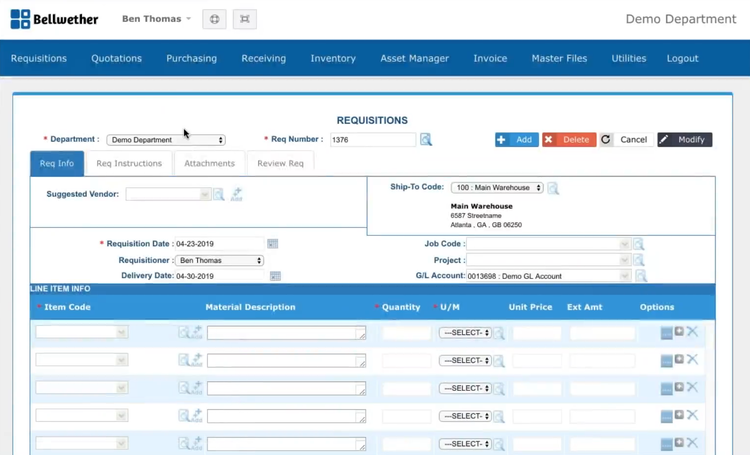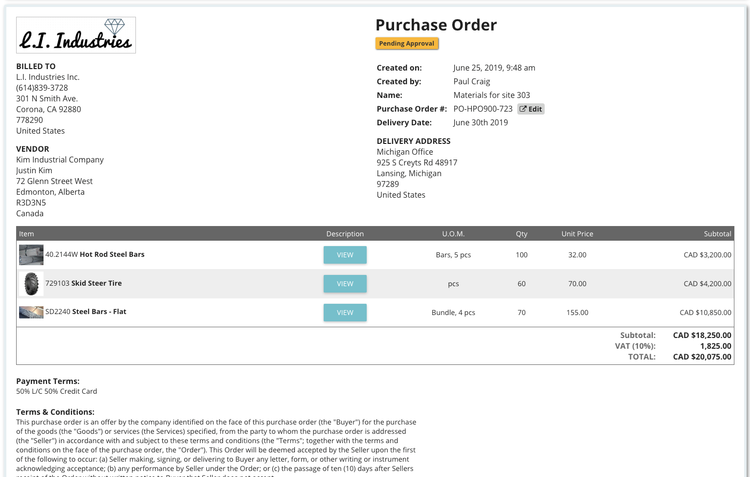Purchase Requisition vs. Purchase Order: Differences and Similarities
The main difference between a purchase requisition and a purchase order is that a purchase requisition is an internal request to buy goods or services, while a purchase order is sent to confirm the purchase of the goods or services. Understanding these documents separately first will give you a better grasp of their differences and similarities in how they function in the purchasing process.
What is a Purchase Requisition?
A purchase requisition is a request for goods or services made by an employee or department that starts the purchasing process. It then goes to the appropriate user for review and approval. Depending on the company, the request might be a physical document requiring real signatures, or the process could be entirely digital thanks to purchase requisition software.
During this stage, the person making the request should include important information regarding the product’s purpose, its cost, and which vendor should be used. The idea is that the requisition should be as clear as possible so that whoever is in charge of approvals can make the best decision quickly.

Along with providing records of all company purchases, these documents offer visibility into spending patterns so organizations can better control costs. For example, a company can compile past requisitions into a catalog detailing pricing and other spending habits.
What is a Purchase Order?
Purchase orders, or POs, are financial documents issued to vendors when buying a product or service. A PO typically includes details on the quantity required, pricing, and shipping or delivery date. All of this information can be taken from the preexisting purchase requisition. The document is then sent to the vendor, starting the purchase process on their end. At this point, it becomes legally binding.
Purchasing workflows used to require a lot of manual processes, especially when it came time to collect signatures for approvals. Purchase order software is a key part of automating the process by digitizing the creation of POs and letting users find and share them without any physical paperwork. This also makes recurring orders easier, as they can be automatically sent on a scheduled basis to keep supply levels steady.

Key Differences
At a glance, POs and purchase requisitions appear the same: documents for buying goods or services. However, they do have fundamental differences, including:
| Difference | Purchase Requisition | Purchase Order |
|---|---|---|
| Purpose | A document used to internally request permission to buy goods or services | A document that is issued by the seller to a buyer confirming the purchase of the goods or services |
| Audience | Internal team members approve or reject the document. | An external seller confirms the purchase. |
| Legality | Not legal in any way. | A legally binding document between the vendor and buyer. |
Anytime someone in your company desires a purchase to be made, they will go through the approval process:
- Employee creates a purchase requisition for an external good or service
- Request goes to management for evaluation
- The decision-maker approves or denies the request
- If approved, the request gets sent to the vendor and becomes a purchase order
As such, a purchase requisition will always come before a PO. Some companies may skip the purchase requisition and move straight to the PO, especially on repeat orders from trusted vendors.
Similarities
Purchase orders and purchase requisitions share some key similarities, including:
- Form: Both are formal documents submitted within the procure-to-pay process.
- Authorization: Both require some form of approval before formal submission. PRs are approved by management internally, while POs are approved by a procurement team before being sent to the vendor.
- Tracking and Auditing: Both documents are stored internally for tracking purposes and can be referenced during audits. They also provide a paper trail for tracking previous company purchases.
Streamline Your Purchasing Processes
Both purchase requests and orders are important parts of procurement. They can show a requisition’s approval status, a company’s overall spend analysis, and even contact details for vendors. By containing everything in a digital format, human error is reduced. If you want to streamline your purchasing processes, check out our software recommendations for the best purchase requisition software and purchase order software**.
